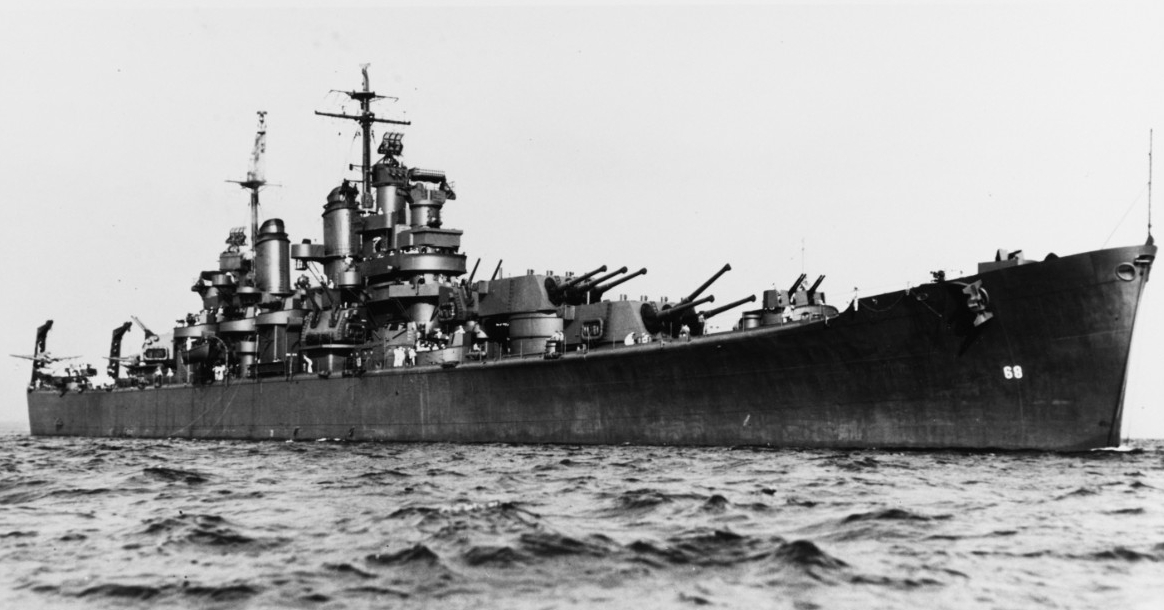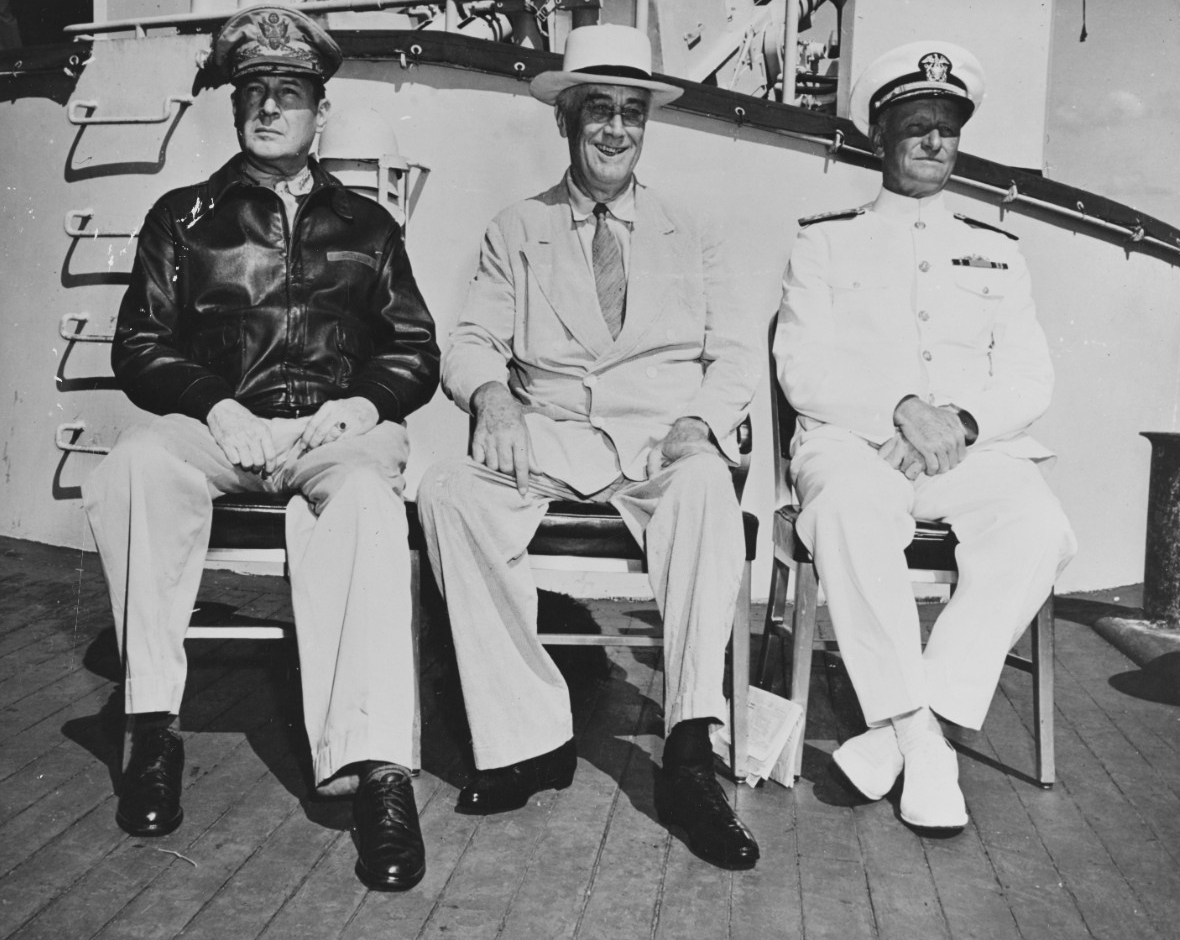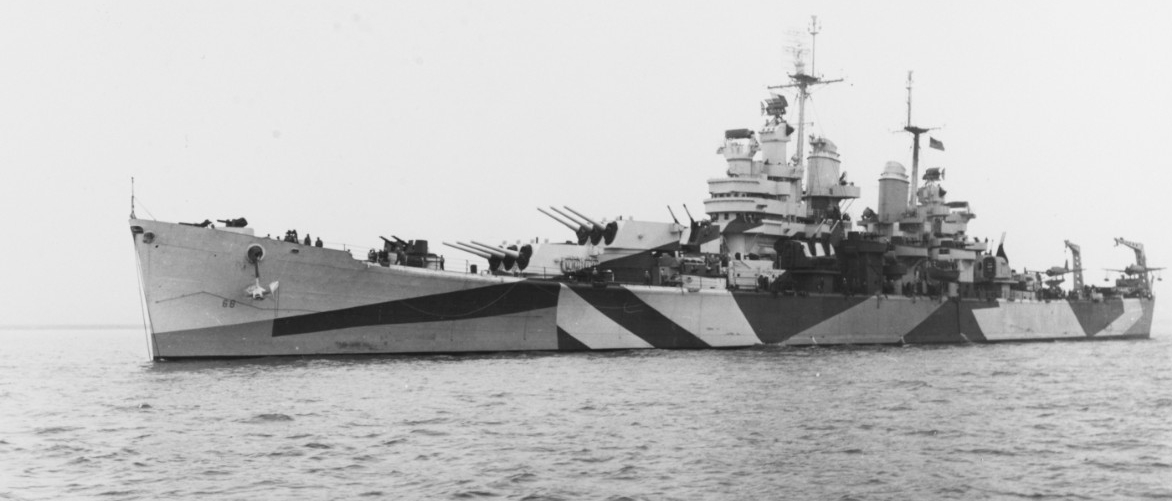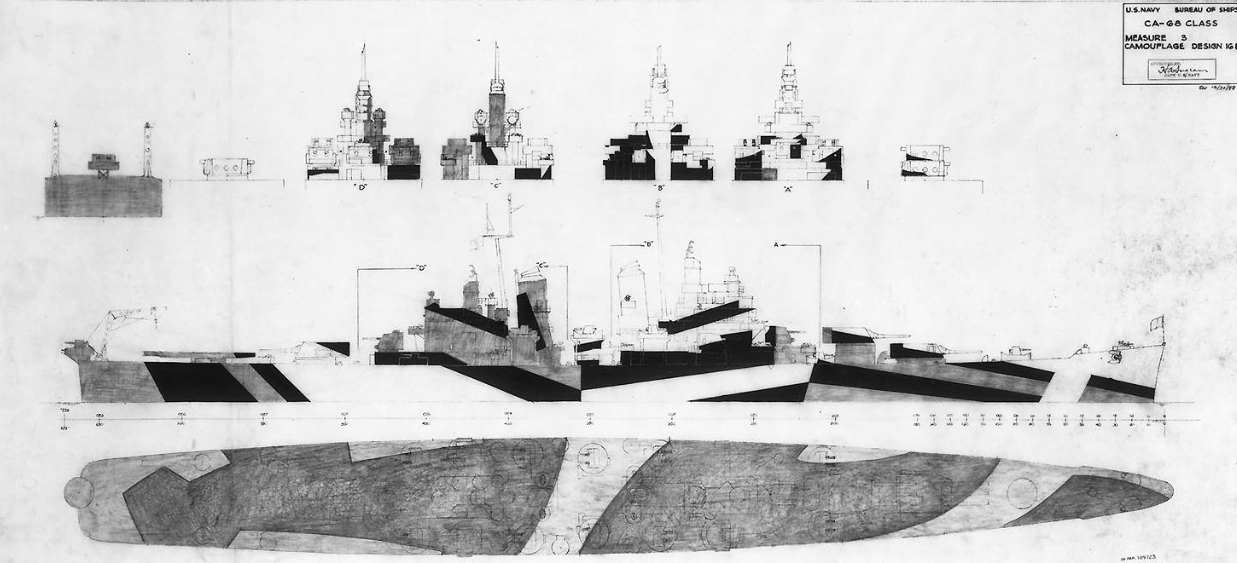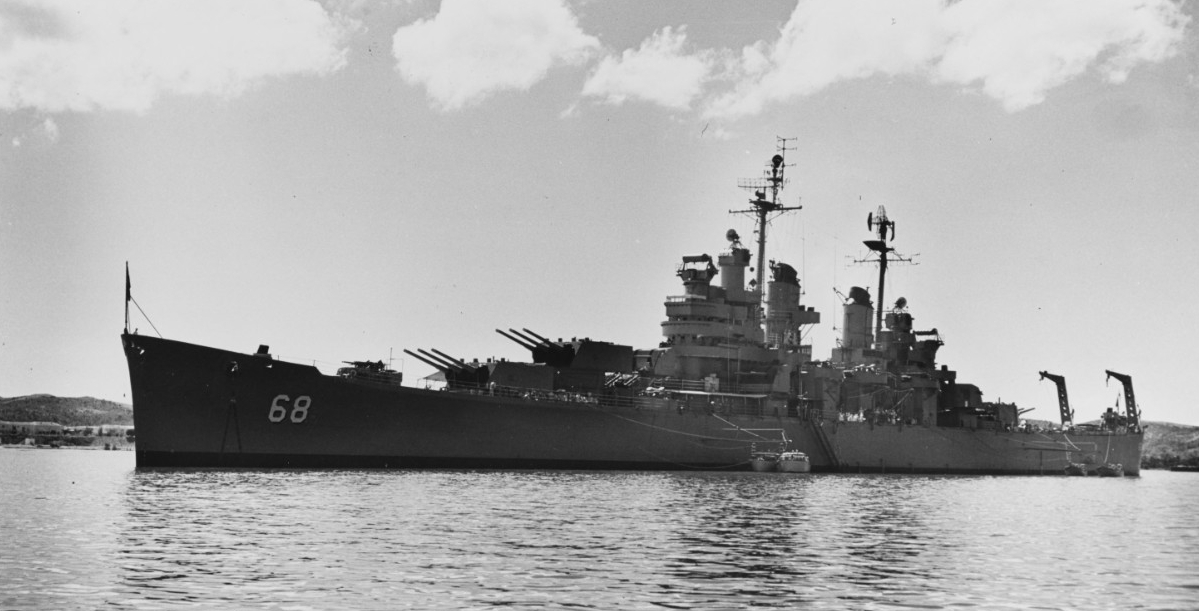Baltimore V (CA-68)
1943–1971
The largest city in Maryland and one of the major seaports of the United States.
V
(CA-68: displacement 13,600 tons; length 673'5"; beam 70'10"; draft 20'6" (mean); speed 33 knots; complement 1,142; armament 9 8-inch, 12 5-inch, 48 40 millimeter, 24 20 millimeter, aircraft 2; class Baltimore)
The fifth Baltimore (CA-68) the leader of a new class of post-Treaty heavy cruisers was laid down on 26 May 1941 at Quincy, Mass., by the Fore River plant of the Bethlehem Steel Corp.; launched on 28 July 1942; sponsored by Mrs. Howard W. Jackson, wife of the Mayor of Baltimore; and commissioned at the South Boston Annex of the Boston Navy Yard on 15 April 1943, Capt. William C. Calhoun in command.
After fitting out, Baltimore sailed for Hampton Roads on 17 June 1943 and proceeded up the Chesapeake to Annapolis. She reached that port on the 20th for a brief visit to the U.S. Naval Academy before returning to the Virginia capes area two days later for exercises. Following brief upkeep at Norfolk from 24 June to 1 July, the new cruiser cleared Hampton Roads on the latter day and headed toward Trinidad, in the British West Indies, for shakedown. She went through her paces intensive training in gunnery out of Port of Spain, Trinidad. Following her return to Hampton Roads on 24 July, she got underway again on the 28th and arrived at Boston that same day for post shakedown availability and repairs to her leaking main battery hydraulic piping. After this work was completed early in September, she proceeded to Norfolk.
On 21 September 1943, the ship sailed for the west coast in company with the destroyer Sigourney (DD-643). Transiting the Panama Canal on the 25th, the two combatants reached San Diego on 4 October. Baltimore then carried out further gunnery exercises and training off the west coast between 9 and 13 October. After standing out of San Diego Bay on the 16th of that month, she tarried briefly at San Francisco before proceeding independently to Pearl Harbor, Territory of Hawaii, where she arrived on the 29th.
Assigned to Task Force (TF) 52, on the last day of October 1943 for training in Hawaiian waters, Baltimore exercised off Oahu until 4 November. She sortied with TF 52 on 10 November, bound for the Gilbert Islands. Baltimore approached Makin Island before dawn on 20 November and, at 0550, catapulted her two Vought OS2U-3 Kingfisher floatplanes for gunnery observation. At 0640, she commenced fire with her 5-inch battery, and her 8-inchers added to the din of bombardment some 40 minutes later. That day, over 1,350 rounds from Baltimore's guns whistled toward the island; but poor visibility prevented accurate spotting by her planes, while indirect fire based on inaccurate navigational fixes meant that some rounds ended up in the sea. While Makin proved to be a comparatively easy conquest, Tarawa, the other objective invaded on the 20th, turned out to be considerably tougher. Baltimore screened the escort carriers operating off Makin through the 24th. The U.S. air umbrella intercepted two low-level fighter sweeps on the 23rd and 24th and largely destroyed both.
When Makin had been secured, Baltimore joined heavy cruisers San Francisco (CA-38), Minneapolis (CA-36), and New Orleans (CA-32) in forming Task Unit (TU) 50.1.1 that screened the carriers of TG 50.1 during a raid on Kwajalein, an atoll in the Marshalls. The photo reconnaissance carried out in this operation proved invaluable for a subsequent raid, and the planes themselves destroyed a large concentration of shipping that the enemy had brought into the area. The U.S. pilots inflicted damage on 12 ships, sinking six of them. However, the light attacks on the airfields at Roi and Wotje in the Marshalls failed to knock out Japanese air power completely enough to prevent a counterattack on the American task force.
Baltimore picked up low-flying planes at 1204 and, moments later, spotted three Kates (Nakajima B5N2 Type 97 carrier attack planes) to starboard, attacking Lexington (CV-16) and other ships. At 1250, Yorktown (CV-10) found herself the object of Japanese attentions, but heavy gunfire from the screening cruisers and destroyers soon knocked down all three attackers. Nevertheless, at 2000, Japanese aircraft commenced moonlight attacks and continued them for the next few hours. Baltimore fired over 1,200 40- and 20-millimeter rounds in the effort to stem the enemy onslaught which, however, succeeded in scoring one torpedo hit on Lexington at 2335.
Baltimore conducted training exercises while returning to Hawaii and arrived at Pearl Harbor on 30 December 1943. After a four-day return to sea for training (2—6 January 1944), the cruiser spent the rest of her time in Hawaii undergoing needed upkeep at Pearl Harbor. Underway on 16 January, she set course for the Marshalls once more.
Assigned to TG 58.4, Baltimore formed part of the screen for Saratoga (CV-3) and the small carriers Princeton (CVL-23) and Cowpens (CVL-25) and conducted exercises en route to the target area. On 29 and 30 January 1944, she supported the carrier strikes against Wotje and Taroa islands, the latter being the center of enemy air strength in the eastern Marshalls. These raids were the last air attack launched to prepare for the invasions of Kwajalein and Majuro. The strikes against Japanese airfields proved to be quite successful, wiping out all enemy air opposition before the landings at the end of January 1944. Baltimore subsequently screened the carriers as their planes blasted targets on Eniwetok on 3 February and, four days later, moored in the newly won Kwajalein lagoon.
As the Fast Carrier Task Forces continued to keep up the relentless pressure on the Japanese in the Central Pacific, Baltimore supported the air strikes that destroyed enemy shipping at Truk on 17 and 18 February 1944. On the 17th, Lt. (j.g.) Denver M. Baxter, A-V(N), USNR, flying one of the heavy cruiser's Vought OS2U-3 Kingfishers with ARMC Reuben F. Hickman on board, covered by two Hellcats, rescued Lt. (j.g.) George M. Blair, A-V(N), USNR, of Fighting Squadron 9 less than 6,000 yards from Dublon Island inside Truk lagoon where he had ditched his flak-crippled Grumman F6F-3 Hellcat.
Returning to Majuro on 26 February, Baltimore replenished there before standing out on 5 March, again with TG 58.4. The group conducted gunnery exercises and training en route to the New Hebrides and reached Espíritu Santo on the 13th. Ten days later, the heavy cruiser sailed for the Palaus as a unit of TG 36.2. On the 29th, as the task force neared those Japanese held islands, she contributed 100 rounds of 5-inch to the barrage put up to discourage attacking Japanese aircraft. The combat air patrol shot down three snoopers while antiaircraft downed at least three during the sporadic attacks.
Baltimore screened the fast carriers while their planes struck targets on the Palaus on the morning of 30 March 1944. Massive sweeps of American fighters knocked down large numbers of enemy fighters on that morning and on the 31st. Seventy-six U.S. Hellcats engaged an estimated 95 Japanese fighters, at a cost of two Americans down in return for 75 Japanese planes destroyed. Further attacks (on Yap, Ulithi and Woleai) followed before Baltimore and her carrier group replenished at Majuro.
Baltimore again sortied with TG 58.2 in mid-April 1944; and, on the 21st, the carriers’ planes, along with those of TG 58.3, pounded airfields at Hollandia, Dutch New Guinea, as well as other nearby targets to prepare the way for the landings at Humboldt Bay and Tanahmerah Bay the following day. TG 58.2 remained in the vicinity through the 23rd, furnishing air support as required, including combat air patrol and antisubmarine patrol over the amphibious forces.
Baltimore continued her vital support role as the massed air groups from 12 carriers struck Japanese shipping, oil and ammunition dumps, aircraft facilities, and other installations at Truk from 29 April to 1 May 1944. Her antiaircraft batteries opened fire on the morning of the 29th, when TG 58.2 brought four attacking torpedo planes under fire. One raider splashed just after crossing the screen; another passed over a carrier without dropping his "fish" only to be destroyed on the far side of the screen; one went down just after releasing its torpedo at Monterey (CVL-24) (which ship took evasive action and avoided it), and the last fell victim to massed gunfire from Yorktown and Monterey just as the point of release.
On 30 April 1944, Baltimore took part in the shelling of Japanese positions at Satawan, contributing over 300 rounds from her 8-inch and 5-inch batteries. The mission assigned to the heavy cruiser and her consorts was "to bombard the air strip and destroy grounded aircraft, facilities, and shipping in order to prevent effective use of [the] field by the enemy in opposing further operations." The following day, 1 May, one of Baltimore's Kingfishers again took center stage, this time by providing gunfire spotting for the battleship North Carolina (BB-55). The heavy cruiser's floatplane filled a gap left by the loss of two of the battleship's own OS2Us in the rescue of downed pilots at Truk.
Having returned to Majuro after the bombardment missions in late April and early May 1944 the heavy cruiser again screened the flattops as they pounded Marcus Island on l9 and 20 May and Wake on the 24th. Upkeep and replenishment at Majuro followed before she returned to sea on 6 June and headed for the Marianas with TG 58.7, screening the fast carriers as their planes rocked Guam and Rota between 11 and 13 June, and Iwo Jima and Chichi Jima between the 15th and 20th. On the latter day, Baltimore recovered a pilot and two crewmen of a plane forced to ditch. The heavy cruiser wound up her service with the screen of the fast carriers during strikes on Pagan Island on 23 June and against Iwo Jima on the 24th.
Recalled to the west coast of the U.S., Baltimore sailed for San Francisco on the latter day [24 June 1944], touched at Eniwetok, in the Marshalls, on the 27th, and at Pearl Harbor on 2 JuIy, before she arrived at Mare Island for a limited availability to ready the ship for service as a Presidential flagship.
Shifting down the coast, Baltimore arrived at San Diego on 18 July and, on the 21st, embarked President Franklin D. Roosevelt and his entourage. She then steamed to Hawaii, embarked Adm. Chester W. Nimitz from a tug slowed off Fort Kamehameha on the 26th, and stood proudly into Pearl Harbor with the Presidential colors at the main, while every ship in the harbor “manned the rail” for this historic visit. In Hawaii, the President and his Chief of Staff, Adm. William D. Leahy, conferred with General Douglas MacArthur and Admiral Nimitz.
From their discussions emerged the decision to bypass the island of Mindanao in seeking to wrest the Philippines from Japanese hands, capturing Leyte first, and then Luzon. President Roosevelt re-embarked in Baltimore on 29 July 1944 and got underway for Alaskan waters. She carried the Chief Executive to Sweeper Bay, Adak, Chinak Island, and Kodiak, as well as to Pleasant Bay and Ice Passage, where the heavy cruiser transferred her distinguished passenger and his party to the destroyer Cummings (DD-365) on 8 August. Escorted by Woodworth (DD-460), Baltimore headed south and put in at San Francisco on 13 August 1944 for drydocking, repairs, and alterations.
The ship left the west coast on 25 October 1944 and once more headed for Hawaiian waters. Reaching Pearl Harbor on 31 October, she exercised off Oahu with the destroyers Colhoun (DD-801) and Bancroft (DD-598), and a group of motor torpedo [PT] boats, before returning to port on 7 November. Standing out of Hawaiian waters on Armistice Day 1944, the heavy cruiser proceeded via Eniwetok to the Western Carolines and entered Ulithi lagoon soon thereafter.
Baltimore sortied from Ulithi on 10 December 1944 as a unit in the screen of TG 38.1 and protected that group’s fast carriers as they hurled strikes against Japanese positions on Luzon between 14 and 16 December. On the 18th, the American warships encountered a typhoon that damaged both of Baltimore’s planes, destroyed her two motor whaleboats, bent 40- and 20-millimeter gun mounts, and buckled deck plates. Other ships that ran into the same tropical storm proved less fortunate: three destroyers capsized and sank, and a score of the larger ships suffered heavy damage.
Returning to Ulithi for voyage repairs on the day before Christmas 1944, Baltimore got underway on 30 December to resume screening the fast carriers. American warplanes devastated Japanese targets on Formosa on 3 and 4 January 1945 and on Luzon between the 6th and the 9th as the invasion of Lingayen Gulf unfolded. On the latter day, the Fast Carrier Task Force entered the South China Sea through the Bashii Channel and hammered targets at Cam Ranh Bay, French Indochina; on Formosa; and at Canton and Hainan Island, China, before returning to waters off Formosa for more strikes on that island. When enemy planes lashed back at the American formations on 21 January the guns of the task force joined its combat air patrol in downing 12 of 15 attackers. The following day, the carriers conducted air strikes on the southern end of Okinawa before retiring to Ulithi to replenish depleted stores.
As flagship for Rear Adm. Lloyd J. Wiltse, Commander, Cruiser Division 10, Baltimore sailed from Ulithi on 10 February 1945, bound for the Japanese home islands. She supported the carrier strikes against Tokyo on 16 and 17 February and against Iwo Jima between 20 February and 5 March. The heavy cruiser then returned to Ulithi to replenish before resuming her screening duties, this time covering the carriers as their planes struck targets on the Japanese island of Kyushu between 18 and 21 March. Here, Baltimore saw vividly the effectiveness of the Divine Wind or kamikaze, the Japanese name for the suicide planes used to inflict grave losses upon their enemy. American aircraft carriers were priority targets for Japanese pilots; and, in those few days off Kyushu, Japanese planes inflicted damage on six "flattops." Nevertheless, the United States Pacific Fleet pressed on launching strikes relentlessly against targets on the southern tip of Okinawa, as well as on islands in the Sakishima and Amami groups. Between 27 March and 30 April, Baltimore covered for the carrier forces hitting the Ryukyus and the Japanese home islands in support of the Okinawa invasion.
After returning to Ulithi on the 30th, Baltimore was again at sea by mid-May 1945, supporting air attacks on Kyushu and Shikoku on the 13th. Heavy air attacks challenged the Americans the following day. Although Navy guns proved equal to the task, downing 25 of 35 attacking aircraft, some of them still managed to penetrate the screen, with one crashing the veteran carrier Enterprise (CV-6). By 17 May, Baltimore was off the east coast of Okinawa and operated in support of the Allied struggle for that island until 5 June, when she endured the fury of a second typhoon, which destroyed her planes and damaged her bow.
Undaunted, Baltimore remained on the "front lines" off Okinawa until the 11th when she sailed for the Philippines. Arriving at Leyte Gulf two days later, the heavy cruiser soon sailed for Hawaii and, proceeding via Eniwetok, reached Pearl Harbor on 12 July 1945. She remained in Hawaiian waters through V-J Day, 15 August 1945, undergoing a navy yard availability and carrying out training through the end of August. During this time, she and the escort vessel Stewart (DE-238) conducted tests off Oahu with Kingfisher floatplanes equipped with Jet Assisted Take Off (JATO) equipment.
In the first few weeks after the war, Baltimore conducted three Magic Carpet voyages bringing home returning servicemen, plying the Pacific between Pearl Harbor and the west coast, calling at San Francisco twice and San Pedro once. Navy Day 1945, 27 October, found her at San Pedro, Calif. Then, on 10 November, the cruiser, with Rear Adm. Emmet P. Forrestel embarked, sailed for Japan. She arrived at Tokyo on 24 November but soon proceeded to Kure where she arrived on the 27th. The cruiser remained there through the end of the year. In early February 1946, Baltimore visited Wakayama, Matsumaya, Sasebo, and Nagasaki before departing Japanese waters on 18 February, bound for home.
She arrived in San Francisco on 3 March 1946. Later, Baltimore moved to Seattle, Wash., where her status was reduced to “in commission, in reserve” on 8 July. Finally, the warship was decommissioned at Bremerton, Wash., on 29 April 1947.
With the expansion of the Navy to meet the challenge imposed by the Korean War, Baltimore was recommissioned at the Puget Sound Naval Shipyard, Bremerton, on 28 November 1951, Capt. Fondville L. Tedder in command. Departing Bremerton on 9 January 1952, she touched at San Francisco from 9 to 11 January and at San Diego from the 12th to the 17th before sailing for Panama. Transiting the canal on 25 and 26 January, the heavy cruiser reached Guantánamo Bay, Cuba, on 28 January. After conducting shakedown training in the West Indies, she sailed north to her newly assigned home port, Boston, for post shakedown availability and preparation for her first deployment to European waters.
Departing Boston on 22 April 1952, the warship reached Gibraltar on 3 May for a wee’'s visit before commencing operations with the Sixth Fleet. For the next five months, she ranged the Mediterranean from Gibraltar to IstanbuI, showing the flag at such ports as Cagliari and Augusta, Sicily; Naples, Taranto, Trieste, and Venice on the Italian “boot,” Cannes, Golfe Juan, Marseille and TouIon, France; and the island of Rhodes. Relieved at Lisbon, Portugal, by her sister ship Columbus (CA-74) in late October, Baltimore sailed for Boston.
Operations off the eastern seaboard, between Hampton Roads and Boston, interspersed with a port visit to Baltimore and a stint of training in the West Indies occupied her time for the next few months. Baltimore returned to the Mediterranean the following spring, making port at Gibraltar on 6 May 1953. After visiting Cagliari, Marseille, and Golfe Juan, she sailed for Portland, England. Arriving there on 8 June, she represented the Navy at Queen Elizabeth II's Coronation Review off Spithead. Leaving the British Isles on 10 June, the warship then returned to the Mediterranean, resuming her rigorous schedule of operations with the 6th Fleet. Baltimore departed Palermo, Sicily, on 12 October; arrived at Boston on 23 October 1953; and remained there until sailing for Guantanamo Bay and refresher training on 3 March 1954. She operated in the West Indies into the spring, visiting Port au Prince, Haiti, and Culebra before heading home. During the voyage north, she visited again the city for which she had been named between 17 and 19 April.
After preparing for her third Mediterranean deployment, Baltimore departed Boston on 4 May 1954 and arrived at Gibraltar on the 18th. Her ports of call on this deployment included cities new to her such as Barcelona and Oran. Late in the summer, the heavy cruiser left Mediterranean for visits to Southend, England, and to several Scandanavian ports: Stockholm, Copenhagen, and Oslo. After touching briefly at Portsmouth, England, from 9 to 11 September on her homeward voyage, the ship arrived at Boston on 18 September.
That deployment to the Sixth Fleet proved to be her last. Reassigned to the Pacific Fleet, the heavy cruiser departed Boston on 5 January 1955; exercised in the Guantánamo Bay area en route; transited the Panama Canal between 16 and 18 January; and, after a stop at Long Beach from 26 January to 8 February, reached her new home port, Pearl Harbor, on Valentine's Day.
She remained there a week before sailing for the Far East on the 21st. Stopping at Midway en route, Baltimore arrived at Yokosuka on 4 March. Deployed to the Seventh Fleet, the heavy cruiser ranged the Far East from Hong Kong to Sasebo, and from Manila Bay to Okinawa and Yokosuka. She also included Sokcho Ri, Korea, Nagasaki, and Kobe in her itinerary, while mixing underway training and TF 77 operations with calls at those and the aforementioned seaports, into the summer of 1955. Clearing Yokosuka on 6 August and steaming via Hawaiian waters, Baltimore reached Long Beach on 22 August. Proceeding to San Francisco and Bremerton, the heavy cruiser arrived at the latter port for inactivation on 29 January 1956.
Placed in commission, in reserve, on the day of her arrival, Baltimore rejoined the Bremerton Group of the Pacific Reserve Fleet and was decommissioned on the last day of May 1956. A third call to duty never came. The cost of activating, repairing, and modernizing the ship was deemed to be disproportionate to her value.
Baltimore remained in reserve for almost a quarter of a century. Her name was struck from the Navy List on 15 February 1971, and she was sold to Zidell Explorations, Inc., of Portland, Oregon, on 10 April 1972 for scrapping and was released from naval custody on 13 July of the same year.
Baltimore (CA-68) received nine battle stars for her World War II service.
Robert J. Cressman
Updated, 11 November 2021

